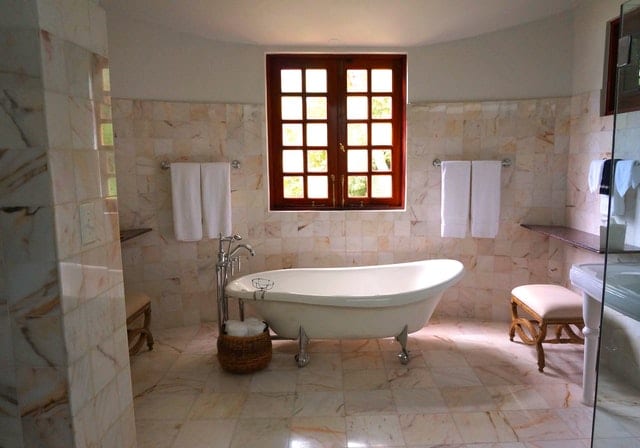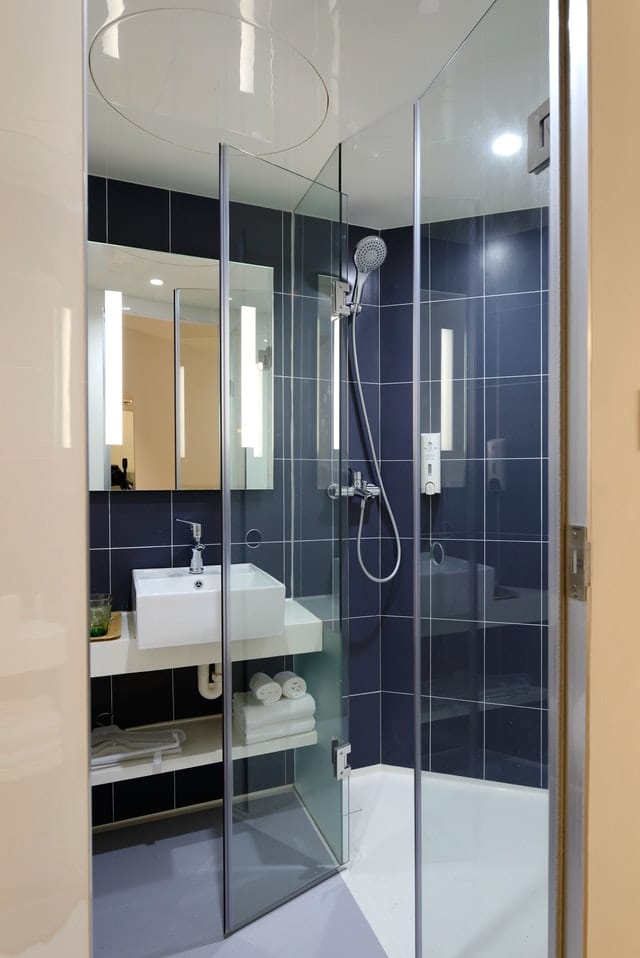How to Paint Bathroom Tiles in 9 Steps

Bathroom tiles waterproof our walls from water damage and provide an elegant decorative touch. They come in an almost endless variety of colours and patterns that can set the vibe and tone of your bathroom. However, if your tiles have lost their lustre over time, painting them provides a cost-effective solution.
But before you get the old paintbrush out to embellish your interior, know there are a few drawbacks to painting floor tiles and walls. Below are the pros and cons of undertaking bathroom tile painting:
Painted Bathroom Tiles – Pros
- A cheaper alternative to re-tiling your bathroom
- Quickly revamps your outdated interior into something more modern
- Customise your bathroom’s look by choosing paint colours to match with other interior elements, e.g. fixtures and your bathroom tub
Painted Bathroom Tiles – Cons
- Excess moisture may cause paint on your wall tiles to peel over time
- It can be a messy, arduous process that may not look perfect when you’re done
- Requires cleaning and other prep work
Now you’re informed of the pros and cons of tile painting, let’s discuss how to do it. Below is a step by step guide on how to paint your bathroom tiles like a professional.
Tiles Painting – Step By Step
1) Clean Your Bathroom Tiles
Dirty tiles will prevent paint from adhering to the surface, resulting in an uneven and patchy finish with paint flakes peeling off. Mix sugar soap and water in a bucket and clean the tiles thoroughly with a scrubber. Keep in mind cleaning is required before painting bathroom floor tiles as well as wall tiles.
Finish off by using a toothbrush or stiff-bristled brush to clean grout lines with your soapy water. If stains are particularly stubborn, spray grout lines with equal parts vinegar and warm water. Let it sit for 15 minutes, then brush again. For mould build-up, it’s recommended to purchase a mould killing cleaner for its proper removal.
Read more about preparing walls for painting here.
2) Remove Loose Paint
If you have painted bathroom tiles, you’ll need to get rid of as much loose paint as possible with a razor blade. Use short strokes and gently scrape off flakes at a 45-degree angle. Wipe away debris as you go along to save time on clean-up once you’re done.
If you have holes, cracks, or chips in your tiles, be sure to patch them before painting. Fill any gaps with a lightweight spackling paste and let dry completely.
3) Sand Bathroom Tiles
For tiles that have experienced wear and tear, sanding is required to ensure your primer and paint sticks to the surface. Use an orbital sander with 220-grit sandpaper and work in small sections for a glossy shine. Always wear a dust mask to protect yourself from any debris.
4) Repeat the Process
For the best possible results, you’ll want to wash grout lines and sand your tiles a second time before you paint. It’ll ensure an even, consistent finish that will make the new paint look clean and professional up close.
5) Use Painter’s Tape
Place painter’s tape around fixtures, windowsills, and door handles to prevent paint from adhering to these surfaces. If you don’t have painter’s tape, masking tape will also suffice.
6) Apply Primer before Brushing and Rolling your Tile Paint
Primers are specially formulated to work to prevent your following paint coats from peeling or bubbling up after drying. For ceramic tiles, use an epoxy or urethane primer and masonry primer for natural stone. Once done, wait for your primer paint to fully dry (read your product’s recommendations to know for sure).
Always identify what your tiles are made of before purchasing a primer. If you’re not sure, err on the side of caution and use a general-purpose primer recommended by a professional. Remember to read product recommendations and instructions before using.
Here are some tips on Choosing The Right Paint.
7) Apply Your Top Coat of Bathroom Tile Paint
Now it’s time to apply your topcoat. Begin by using a clean and well-maintained paintbrush to cut in around tiles, corners, and other tight spaces that you can’t reach with a roller. Finish painting your tiles with a roller to ensure they’re entirely covered.
Once done, wait for eight hours and apply a second coat of paint.
8) Make Tile Patterns (Optional)
Add a fun touch with a stencil if plain coloured tiles aren’t your thing. You can find plenty of stencils online or create your own, which adds personalisation to your bathroom. Stick your stencil onto the surface and use a hand-held roller to paint over your stencil.
9) Seal Your Bathroom Tiles
Once your paint has dried completely, apply a sealer with a paintbrush onto your bathroom tiles. Allow the sealer to dry for five minutes and give them a wipedown. A sealer ensures longevity by protecting your tiles from moisture, dirt, and scuff marks.
Painting bathroom tiles is easy if you have the proper know-how and patience. Take your time and allow each layer to dry before applying the next. You’ll be left with shiny, new tiles that look stunning!
Find a way to Get Rid of Paint Smells
An FAQ on Tiles Painting
What kind of paint do you use on bathroom tiles?
We recommend epoxy paint for areas exposed to hard water, like your backsplashes and countertops. This paint type is formulated to withstand humid conditions without bubbling or peeling. For drier areas like floors, you can use latex paint to paint tile floors. Just be sure to purchase a high-quality brand from a trusted supplier for the best results.
How long does tile paint last in the shower?
This will depend on your paint applied, how well you resealed your tiles, the quality of your bathroom tile and how often the room is used. Generally speaking, you should paint bathroom tiles with epoxy or urethane paints because they resist moisture better. Tile paint typically lasts several years if the job is done correctly, and with a regular cleaning schedule, your paint may even last longer.
Looking into waterproof paint? Read this!
Can you paint over shower tiles?
Yes, you can paint over tiles with epoxy paint. This paint type is most suited for your shower as it’s highly resistant to incoming water.
Is painting tiles a good idea?
The decision to paint bathroom tiles is good if you want to change their colour, protect them from damage or give your bathroom a new theme. This project is relatively straightforward and shouldn’t need professional assistance. As long as you have the right tools and follow our tips, we say go for it!
If, however, you think the task is something you’d rather leave in the hands of professional painting services,
Newline Painting – Painting Melbourne Interiors & Exteriors for Affordable Prices
If your bathroom or any other part of your home is looking dingy, Newline Painting can help. We offer affordable painting services for different materials, including tiles, walls, ceilings, and more. Our qualified Melbourne professionals painters are dedicated to providing quality painting services for interior and exterior surfaces. Our services are available across Melbourne, including Armadale, Carlton, Frankston, Malvern, and Ringwood.
Call us today at 1300 044 206 or fill out our contact form to book an appointment. We offer free quotes so you can get an estimate on the cost of your project without any obligations. Here are some tips on how to How to Choose the Right Painter for Your Home or Commercial Property.


